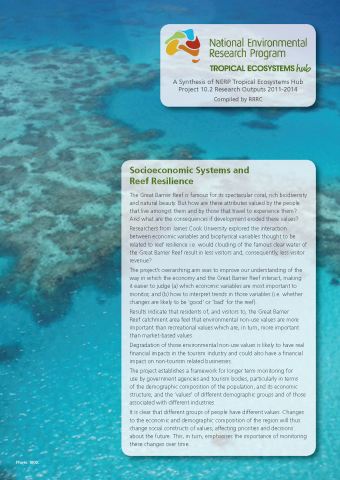Resources
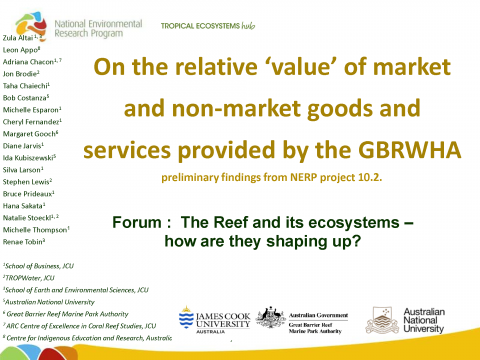 Zula Altai (JCU), Leon Appo (ACU), Adriana Chacon (JCU), Jon Brodie (JCU), Taha Chaiechi (JCU), Bob Costanza (JCU), Michelle Esparon (JCU), Cheryl Fernandez (JCU), Margaret Gooch (GBRMPA), Diane Jarvis (JCU), Ida Kubiszewski (JCU), Silva Larson (JCU), Stephen Lewis (JCU), Bruce Prideaux (JCU), Hana Sakata (JCU), Natalie Stoeckl (JCU), Michelle Thompson (JCU), Renae Tobin (JCU); On the relative ‘value’ of market and non-market goods and services provided by the GBRWHA; Thursday 9th May 2013.
Zula Altai (JCU), Leon Appo (ACU), Adriana Chacon (JCU), Jon Brodie (JCU), Taha Chaiechi (JCU), Bob Costanza (JCU), Michelle Esparon (JCU), Cheryl Fernandez (JCU), Margaret Gooch (GBRMPA), Diane Jarvis (JCU), Ida Kubiszewski (JCU), Silva Larson (JCU), Stephen Lewis (JCU), Bruce Prideaux (JCU), Hana Sakata (JCU), Natalie Stoeckl (JCU), Michelle Thompson (JCU), Renae Tobin (JCU); On the relative ‘value’ of market and non-market goods and services provided by the GBRWHA; Thursday 9th May 2013.
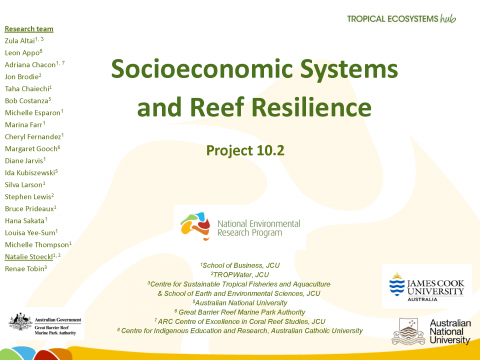 Natalie Stoeckl (JCU); Socioeconomic systems and reef resilience; Wednesday 5th November.
Natalie Stoeckl (JCU); Socioeconomic systems and reef resilience; Wednesday 5th November.
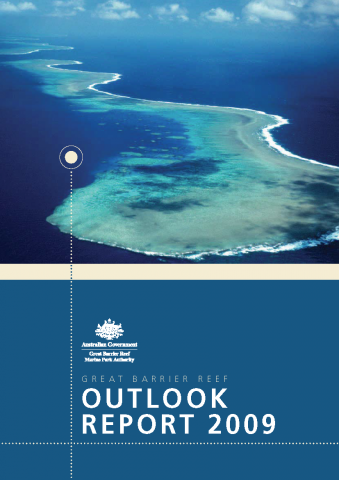 The Great Barrier Reef Outlook Report 2009 is a stock-take of the Great Barrier Reef, its management and its future.
The Great Barrier Reef Outlook Report 2009 is a stock-take of the Great Barrier Reef, its management and its future.
The aim of the Outlook Report is to provide information about:
- The condition of the ecosystem of the Great Barrier Reef Region (including the ecosystem outside the Region where it affects the Region);
• Social and economic factors influencing the Great Barrier Reef ecosystem;
• Management effectiveness of the Great Barrier Reef; and
• Risk-based assessment of the long-term outlook for the Region.
The Report underpins decision-making for the long term protection of the Great Barrier Reef. It was prepared by the GBRMPA based on the best available information and was independently peer reviewed. Many people contributed to the development of the Outlook Report including:
• Australian and Queensland Government agencies
• Leading Great Barrier Reef scientists and researchers
• Industry representatives
• Advisory committees
• Members of regional communities and the public.
The publication of an Outlook Report was a key recommendation of the review of the Great Barrier Reef Marine Park Act 1975. A report is to be prepared every five years and given to the Minister for Sustainability, Environment, Water, Population and Communities for tabling in both houses of the Australian Parliament.
The Great Barrier Reef Outlook Report 2009 is the first of these reports.
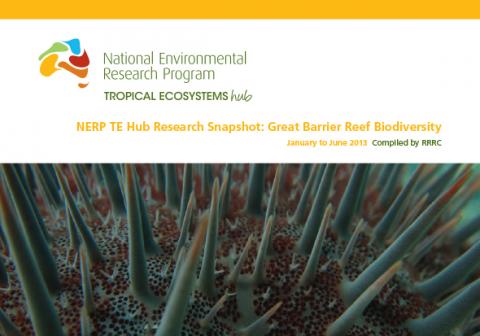 A snapshot of the research progress within the Great Barrier Reef Biodiversity node for January to June 2013.
A snapshot of the research progress within the Great Barrier Reef Biodiversity node for January to June 2013.
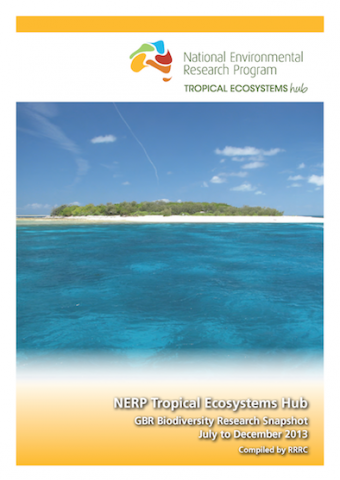 A snapshot of the research progress within the Great Barrier Reef Biodiversity node for July to December 2013.
A snapshot of the research progress within the Great Barrier Reef Biodiversity node for July to December 2013.
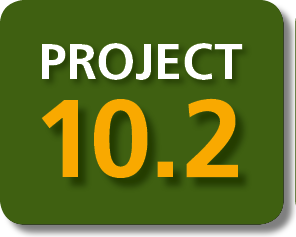
 The Great Barrier Reef (GBR) is famous for its spectacular coral, rich biodiversity and natural beauty. However, none of these important assets are bought or sold in the marketplace, so none are explicitly ‘valued’ with a price. Recognising that absence of price does not mean absence of value, this project seeks to improve our understanding of these non-market ‘values’ to a variety of different stakeholders. How important are pristine beaches, iconic marine mammals or healthy coral reefs to the community, tourists and the tourism industry? How would people feel if some of these ‘values’ were degraded (e.g. if water clarity declined, or if fish were less abundant)?
The Great Barrier Reef (GBR) is famous for its spectacular coral, rich biodiversity and natural beauty. However, none of these important assets are bought or sold in the marketplace, so none are explicitly ‘valued’ with a price. Recognising that absence of price does not mean absence of value, this project seeks to improve our understanding of these non-market ‘values’ to a variety of different stakeholders. How important are pristine beaches, iconic marine mammals or healthy coral reefs to the community, tourists and the tourism industry? How would people feel if some of these ‘values’ were degraded (e.g. if water clarity declined, or if fish were less abundant)?

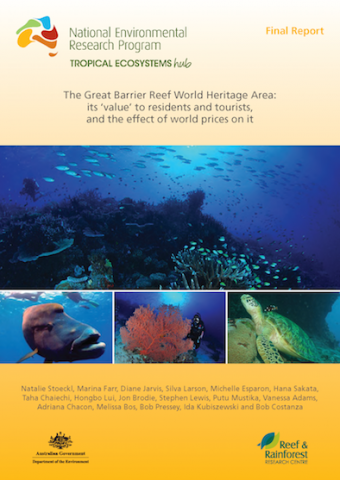 Stoeckl, N., Farr, M., Jarvis, D., Larson, S., Esparon, M., Sakata, H., Chaiechi, T., Lui, H., Brodie, J., Lewis, S., Mustika, P., Adams, V., Chacon, A., Bos, M., Pressey, B., Kubiszewski, I., Costanza, B. (2014) The Great Barrier Reef World Heritage Area: its ‘value’ to residents and tourists, and the effect of world prices on it.
Stoeckl, N., Farr, M., Jarvis, D., Larson, S., Esparon, M., Sakata, H., Chaiechi, T., Lui, H., Brodie, J., Lewis, S., Mustika, P., Adams, V., Chacon, A., Bos, M., Pressey, B., Kubiszewski, I., Costanza, B. (2014) The Great Barrier Reef World Heritage Area: its ‘value’ to residents and tourists, and the effect of world prices on it.
© JCU
![]() NERP-TE-PROJECT-10.2-FINAL-REPORT-PARTA
NERP-TE-PROJECT-10.2-FINAL-REPORT-PARTA
![]() NERP-TE-PROJECT-10.2-FINAL-REPORT-PARTB
NERP-TE-PROJECT-10.2-FINAL-REPORT-PARTB

Jarvis, D., Stoeckl, N., Chaiechi, T. (2014) Applying econometric techniques to hydrological problems in a large basin: Quantifying the rainfall–discharge relationship in the Burdekin, Queensland, Australia. Journal of Hydrology. 496, 107-121 [doi: 10.1016/j.jhydrol.2013.04.043].

Environmental and Natural Resources Research
Larson, S., Farr, M., Stoeckly, N., Chacon, A., Esparon, M. (2014) Does Participation in Outdoor Activities Determine Residents’ Appreciation of Nature: A Case Study From the Great Barrier Reef, Australia. Environmental and Natural Resources Research. 4 (3) [doi: 10.5539/enrr.v4n3p212].
